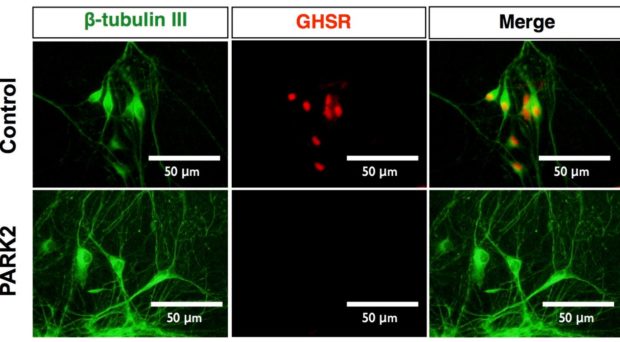
What is Ghrelin and why is it important?
Parkinson’s disease is characterised by a loss of dopaminergic neurons within areas involved in motor coordination, primarily resulting in motor deficits. Ghrelin has a role in activating dopaminergic neurons by acting as a ligand for the growth hormone secretagogue receptor (GHSR). GHSR is found throughout the body but can also be found in small amounts in the brain, particularly in the Pars Compacta portion of the substantia nigra (SNc).

Ghrelin activation of SNc dopaminergic neurons feeds into an area within the basal ganglia, known as the striatum. This area plays a central role in motor action and planning, communicating with other brain areas, including the thalamus which relays these motor signals to areas of the cortex involved in movement generation and coordination.
Activation of dopamine neurons in the SNc causes an increase in the enzyme tyrosine hydroxylase in the midbrain, which increases dopamine turnover in the striatum.

Higher numbers of GHSR and tyrosine hydroxylase co-expressing neurons have been identified in the SNc than other parts of the brain. These lost neurons primarily project into the SNc affecting its influence on the basal ganglia’s motor coordination.
What was done in this study?
To study the changes in Ghrelin within Parkinson’s disease patients, Professor Narita et al generated disease specific dopaminergic neurons from the skin cells of Parkinson’s patients, whose disease was a result of a genetic mutation in the PARK2 gene. This allowed for recapitulation of the disease in a human relatable model as the disease phenotypes were retained in the generated neurons.
They found a significant decrease in the mRNA levels and protein expression of the GHS receptors, in both the disease specific iPSCs generated from patient samples, and those generated in vivo using the technology CRISPR/Cas9 to introduce the PARK2 gene mutation.
 In order to investigate whether direct inhibition of GHSR function in the brain can affect motor coordination, researchers conducted an in vivo evaluation in a normal mouse model. These mice were injected in the brain with a GHSR agonist ([D-lys3]-GHRP-6). This induced a dose dependent impairment of motor coordination, demonstrated by the reduced time for which the mouse could stay on in a rotarod test.
In order to investigate whether direct inhibition of GHSR function in the brain can affect motor coordination, researchers conducted an in vivo evaluation in a normal mouse model. These mice were injected in the brain with a GHSR agonist ([D-lys3]-GHRP-6). This induced a dose dependent impairment of motor coordination, demonstrated by the reduced time for which the mouse could stay on in a rotarod test.
This evidence, along with the down regulation of GHSR seen in in the iPSCs, suggests that deficits in GHSR activity in the SNc caused by neuronal loss may be part of the symptomatic development of Parkinson’s disease.
But how might this implicate Parkinson’s patients in the future?
Although further analysis may be required to identify exactly how the PARK2 mutation affects GHSR expression it is clear that down regulation of Ghrelin receptors in dopaminergic neurons play a role in the initial dysfunction of the neurons, leading to motor dysfunction seen in Parkinson’s.
Identification of this biochemical change could provide an alternative route of therapeutic targets for Parkinson’s patients. The use of Ghrelin and its pathway as a therapeutic route is supported by previous studies which showed that Ghrelin restricts dopamine cell loss in the SNc and striatum in mice due to its neuroprotective properties.
Lizzie Anderson
Latest posts by Lizzie Anderson (see all)
- The new protein on the learning and memory scene: Sirtuin 6 - 31st October 2018
- Autism Awareness Week Quiz 2018 - 26th March 2018
- Ghrelin: a new therapeutic target for Parkinson’s? - 20th February 2018
Comments